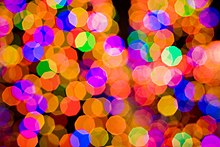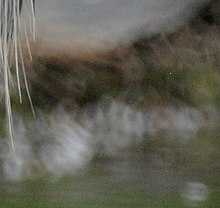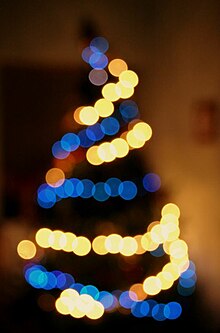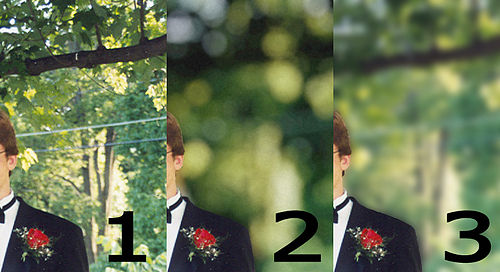Bokeh

In photography, bokeh (Originally /[invalid input: 'icon']ˈboʊkɛ/,[1] /[invalid input: 'icon']ˈboʊkeɪ/ BOH-kay — also sometimes heard as /[invalid input: 'icon']ˈboʊkə/ BOH-kə,[2] Japanese: [boke]) is the blur,[3][4] or the aesthetic quality of the blur,[5][6][7] in out-of-focus areas of an image. Bokeh has been defined as "the way the lens renders out-of-focus points of light".[8] However, differences in lens aberrations and aperture shape cause some lens designs to blur the image in a way that is pleasing to the eye, while others produce blurring that is unpleasant or distracting—"good" and "bad" bokeh, respectively.[3] Bokeh occurs for parts of the scene that lie outside the depth of field. Photographers sometimes deliberately use a shallow focus technique to create images with prominent out-of-focus regions.
Bokeh is often most visible around small background highlights, such as specular reflections and light sources, which is why it is often associated with such areas.[3] However, bokeh is not limited to highlights; blur occurs in all out-of-focus regions of the image.
Origin
The term comes from the Japanese word boke (暈け or ボケ), which means "blur" or "haze", or boke-aji (ボケ味), the "blur quality". The Japanese term boke is also used in the sense of a mental haze or senility.[9] The term bokashi (暈かし) is related, meaning intentional blurring or gradation.
The English spelling bokeh was popularized in 1997 in Photo Techniques magazine, when Mike Johnston, the editor at the time, commissioned three papers on the topic for the March/April 1997 issue; he altered the spelling to suggest the correct pronunciation to English speakers, saying "it is properly pronounced with bo as in bone and ke as in Kenneth, with equal stress on either syllable".[4] The spellings bokeh and boke have both been in use at least since 1996, when Merklinger had suggested "or Bokeh if you prefer."[10] The term bokeh has appeared in photography books at least since 1998.[5] It is sometimes pronounced /ˈboʊkə/ (boke-uh).[2]
Description
Although difficult to quantify, some lenses enhance overall image quality by producing more subjectively pleasing out-of-focus areas. Good bokeh is especially important for large-aperture lenses, macro lenses, and long telephoto lenses because they are typically used with a shallow depth of field. Bokeh is also important for medium telephoto "portrait lenses" (typically 85–150 mm on 35 mm format) because in portraiture photography, the photographer typically seeks to obtain a shallow depth of field to achieve an out-of-focus background and make the subject stand out.
Bokeh characteristics may be quantified by examining the image's circle of confusion. In out-of-focus areas, each point of light becomes an image of the aperture, generally a more or less round disc. Depending how a lens is corrected for spherical aberration, the disc may be uniformly illuminated, brighter near the edge, or brighter near the center. Lenses that are poorly corrected for spherical aberration will show one kind of disc for out-of-focus points in front of the plane of focus, and a different kind for points behind. This may actually be desirable, as blur circles that are dimmer near the edges produce less-defined shapes which blend smoothly with the surrounding image. Lens manufacturers including Nikon, Minolta, and Sony make lenses designed with specific controls to change the rendering of the out-of-focus areas.
 |
 |
 |
 |
 |
 |

The shape of the aperture has an influence on the subjective quality of bokeh as well. For conventional lens designs (with bladed apertures), when a lens is stopped down smaller than its maximum aperture size (minimum f-number), out-of-focus points are blurred into the polygonal shape formed by the aperture blades. This is most apparent when a lens produces hard-edged bokeh. For this reason, some lenses have many aperture blades and/or blades with curved edges to make the aperture more closely approximate a circle rather than a polygon. Minolta has been on the forefront of promoting and introducing lenses with near-ideal circular apertures since 1987, but most other manufacturers now offer lenses with shape-optimized diaphragms, at least for the domain of portraiture photography. In contrast, a catadioptric telephoto lens renders bokehs resembling doughnuts, because its secondary mirror blocks the central part of the aperture opening. Recently, photographers have exploited the shape of the bokeh by creating a simple mask out of card with shapes such as hearts or stars, that the photographer wishes the bokeh to be, and placing it over the lens.[11]
Leica lenses, especially vintage ones, are often claimed to excel in bokeh quality[citation needed], although Leica photographers have tended to make more use of maximum aperture due to the lenses' ability to maintain good sharpness at wide openings and the suitability of the Leica camera system for available-light theatre work and reportage. This reputation is founded on the excellence of Leitz/Leica pre-war lenses, which were at the forefront of complex mathematical design and manufacturing know-how, at a time when all computations and glass making were done by hand.
The Minolta/Sony STF 135mm f/2.8 [T4.5] (with STF standing for smooth trans focus) is a lens which is specifically designed to produce pleasing bokeh. An apodization filter is used to soften the aperture edges which results in a smooth defocused area with gradually fading circles. Those qualities make it the only lens of this kind currently on the market.
The Nikon 105 mm DC and 135 mm DC lenses (DC stands for "Defocus Control") have a control ring that permits the over-correction or under-correction of spherical aberration to change the bokeh in front of and behind the focal plane.
Emulation

| No bokeh or blur | Synthetic bokeh | Gaussian blur |
|---|
Bokeh can be simulated by convolving the image with a kernel that corresponds to the image of an out-of-focus point source taken with a real camera. Unlike conventional convolution, this convolution has a kernel that depends on the distance of each image point and – at least in principle – has to include image points that are occluded by objects in the foreground.[12] Also, bokeh is not just any blur. To a first approximation, defocus blur is convolution by a uniform disk, a more computationally intensive operation than the "standard" Gaussian blur; the former produces sharp circles around highlights whereas the latter is a much softer effect. Diffraction may alter the effective shape of the blur. Some graphics editors have a filter to do this, usually called "Lens Blur."[13]
An alternative mechanical mechanism has been proposed for generating bokeh in small aperture cameras such as compacts or cellphone cameras, called image destabilisation,[14][15] in which both the lens and sensor are moved in order to maintain focus at one focal plane, while defocusing nearby ones. This effect currently generates blur in only one axis.
Other applications
In 2009,[16] a research group at MIT Media Lab showed that the bokeh effect can be used to make imperceptibly small barcodes, or bokodes. By using barcodes as small as 3 mm with a small lens over them, if the barcode is viewed out of focus through an ordinary camera focused at infinity, the resulting image is large enough to scan the information in the barcode.[17]
See also
References
- ^ "Bokeh in Pictures". Luminous-landscape.com. 2004-04-04. Retrieved 2011-11-15.
- ^ a b Wes McDermott (2009). Real World Modo: The Authorized Guide: In the Trenches with Modo. Focal Press. p. 198. ISBN 978-0-240-81199-4.
- ^ a b c Harold Davis (2008). Practical Artistry: Light & Exposure for Digital Photographers. O'Reilly Media. p. 62. ISBN 978-0-596-52988-8.
- ^ a b
Johnston, Mike (April 4, 2004). "The Sunday Morning Photographer, 2004: Bokeh in Pictures". The Luminous Landscape. Retrieved July 3, 2009.
{{cite web}}: External link in|publisher= - ^ a b Gerry Kopelow (1998). How to photograph buildings and interiors (2nd ed.). Princeton Architectural Press. pp. 118–119. ISBN 978-1-56898-097-3.
- ^ Roger Hicks and Christopher Nisperos (2000). Hollywood Portraits: Classic Shots and How to Take Them. Amphoto Books. p. 132. ISBN 978-0-8174-4020-6.
- ^ Tom Ang (2002). Dictionary of Photography and Digital Imaging: The Essential Reference for the Modern Photographer. Watson–Guptill. ISBN 0-8174-3789-4.
- ^ "PhotoWords/Lens". PhotoGuide Japan.
- ^ John W. Traphagan (2000). Taming oblivion: aging bodies and the fear of senility in Japan. SUNY Press. p. 134. ISBN 978-0-7914-4499-3.
- ^
Merklinger, Harold. "Understanding Boke". The Luminous Landscape. Retrieved July 3, 2009.
{{cite web}}: External link in|publisher= - ^ Karsten Stroemvig. "DIY — Create your own Bokeh".
- ^ Potmesil, M.; Chakravarty, I. (1982), Synthetic Image Generation with a Lens and Aperture Camera Model, ACM Transactions on Graphics, vol. 1, ACM, pp. 85–108, doi:10.1145/357299.357300, ISSN 0730-0301
- ^ Adobe Photoshop CS3 Livedocs. "Add lens blur".
{{cite web}}: CS1 maint: numeric names: authors list (link) - ^ Giles, Jim. "Next-generation cameras bring photography tricks to the masses". New Scientist (Subscription required). Retrieved 2011-04-04.
- ^ Ankit Mohan and Douglas Lanman and Shinsaku Hiura and Ramesh Raskar. "Image Destabilization: Programmable Defocus using Lens and Sensor Motion".
- ^ Fildes, Jonathan (2009-07-27). "Technology | Barcode replacement shown off". BBC News. Retrieved 2012-02-19.
- ^ Mohan, A., Woo, G, Hiura, S, Smithwick, Q, Raskar, R. Bokode: Imperceptible Visual Tags for Camera Based Interaction from a Distance. ACM SIGGRAPH 2009.
External links
- Aperture Simulator Java iris and effect simulator
- How to evaluate bokeh
- Understanding Bokeh
- Bokeh in olypedia.de (German)
